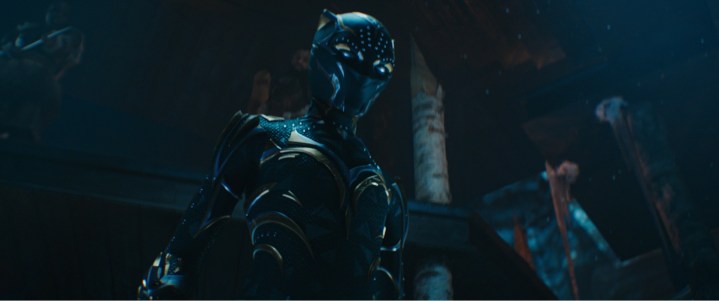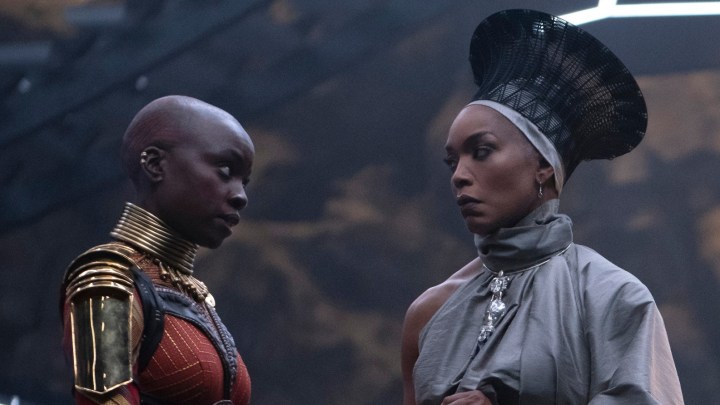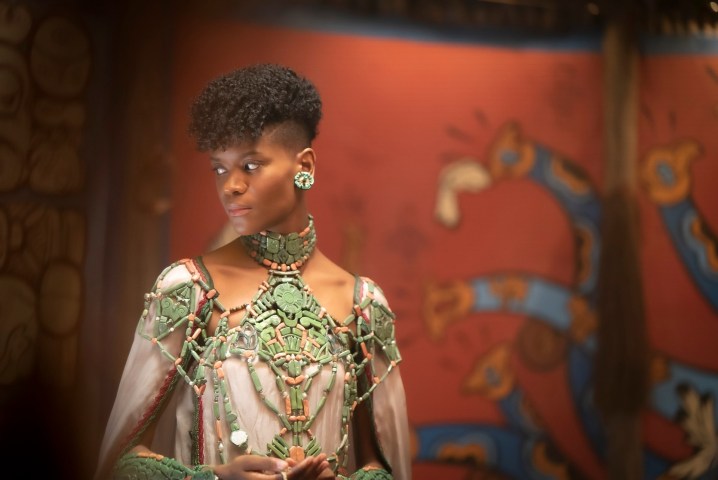“It offers a powerful tribute to Chadwick Boseman, but Black Panther: Wakanda Forever sometimes feels like an MCU movie drowning in uncertainty.”
- Fitting tribute to Chadwick Boseman
- Compelling new villain
- Powerful performances
- Story spread too thin
- Weak action
- Disconnected from MCU
The death of Black Panther star Chadwick Boseman in 2020 left a massive void in the Marvel Cinematic Universe, with no project more affected by the talented actor’s tragic passing than Black Panther: Wakanda Forever, the sequel to his groundbreaking 2018 film.
One of Marvel’s most successful solo superhero films of all time (both critically and commercially), Black Panther became the first superhero movie to earn a Best Picture nomination at the Academy Awards, only to face an uncertain future after Boseman’s death. Two years after the MCU star’s passing, Black Panther: Wakanda Forever arrives in theaters with plenty of questions to answer about the direction the franchise will go and how it will acknowledge — and honor — Boseman’s legacy.
While Wakanda Forever does a tremendous job of paying tribute to Boseman and exploring the ways we process grief, its understandable need to lean into those themes leaves little room for the other elements it introduces to Marvel’s movieverse. The end result is a film that feels more like a crowded interlude than a fully realized chapter in the MCU saga.

The story so far
Directed by returning Black Panther filmmaker Ryan Coogler from a script he co-wrote with Joe Robert Cole (The People v. O. J. Simpson), Black Panther: Wakanda Forever picks up with the death of T’Challa (Boseman), the nation of Wakanda’s monarch and protector. The film explores the aftermath of Wakanda’s suddenly vacant throne and the power vacuum that creates — both within the country and internationally.
As T’Challa’s mother, Queen Ramonda (Angela Bassett), and sister, Shuri (Letitia Wright), process their grief in very different ways, they’re soon presented with another challenge when the ruler of the undersea kingdom of Talokan, Namor (Tenoch Huerta Mejía), threatens Wakanda. The ensuing conflict tests the resolve of Wakanda’s royal family and their allies and puts the entire nation at a turning point in its history.

A cinematic eulogy
From the very first seconds of Wakanda Forever, the film does an impressive job of both integrating and honoring Boseman’s death and legacy in the MCU.
T’Challa’s death in Marvel’s movie universe shares plenty of similarities with the actor’s real-world passing — a tragedy that seemingly took everyone outside his closest circles by surprise. Marvel’s superheroes are larger-than-life characters, but T’Challa’s death is positioned as a reminder that life remains just as unpredictable in the MCU, and that sometimes, no amount of science or magic can stop people from being taken from us far too soon.
T’Challa’s death — and its aftermath — is handled with a careful, but heart-wrenchingly effective touch, and there’s a sense that the scenes in which characters mourn his passing were an essential part of the grieving process for Boseman’s real-world friends and film family. The sincerity and power of those moments and the conversations that happen around them are a testament to Coogler’s ability to blur that line between the fantasy world of the MCU and the experiences of everyone whose lives Boseman touched.
That’s no easy line to walk, but he does so with a beautifully sensitive eye toward both the very real man and the legacy of the character he left behind. The film’s final scene offers a symbolic, and surprisingly cathartic endpoint in the journey through grief explored by Wakanda Forever, and Coogler manages to find just the right emotional note to strike in that moment.

Spread too thin
Sadly, the rest of the film doesn’t fare as well, with a long list of major plot points, characters, and concepts introduced and seemingly pushed to the background as Wakanda Forever explores the more emotional — and arguably, more important — aforementioned themes.
Mejía delivers a strong, nuanced performance as Namor, whose own origins and those of his kingdom have been shaped by tragedy and senseless death. He’s a fascinating character in the MCU, with more depth and shades of gray than his comics counterpart, and the Mayan influence on both the character and Talokan is a welcome addition to the tapestry of the MCU.
Much like Michael B. Jordan’s “Killmonger” character in Black Panther, Mejía’s Namor is a standout in the film, but his story arc in Wakanda Forever takes a backseat to the emotional journey Shuri, Ramonda, and the other Wakandan characters undertake in the film, which blunts the impact of his debut a bit. The fact that his entrance to the MCU also introduces an entirely new kingdom that rivals Wakanda, and that he’s the first character to be officially identified as a “mutant” (paving the way for the X-Men), would normally represent a seismic shift in the MCU. But it’s all just narrative backfill in Wakanda Forever.
In fact, much of Wakanda Forever feels only tangentially connected to the MCU, with Martin Freeman and Julia Louis-Dreyfus appearing as the only non-Wakandan, returning Marvel characters in the film. Their roles feel unnecessary in the larger story the film is telling, though, and their performances are wasted in a story that didn’t actually have any use for them.

Mejía isn’t the only character to deliver a strong performance in Wakanda Forever, though. Bassett and Danai Gurira, who portrays Wakandan special forces leader general Okoye, repeatedly deliver some of the film’s most powerful scenes, and their performances boil over with energy and emotion.
One particular scene between Bassett and Gurira explodes with the sort of dramatic heft that few moments in the MCU have matched and serves as a reminder of the strength they bring to Marvel’s evolving, over-arching story.
The film also features a strong debut for Dominique Thorne as Riri Williams, a brilliant, teenage engineer who’s expected to lead her own spin-off series, Ironheart, set after the events of Wakanda Forever. Thorne’s character is a good counterpoint to Wright’s Shuri, also a brilliant engineer, and the differences in their respective backgrounds let them bounce off each other in some entertaining ways. Riri doesn’t get much time in the spotlight, but the attention she does receive is effective in teasing more intriguing adventures to come for her.

Growing pains
Unfortunately, the one character who receives the biggest upgrade in screen time in Wakanda Forever, Shuri, doesn’t entirely rise to the occasion.
After playing a supporting part in Black Panther and her other MCU appearances, Wright’s character is thrust into the spotlight in Wakanda Forever but never feels very comfortable in an expanded role. Until this point, Shuri’s role has often been a source of comic relief, positioned as T’Challa’s tech-obsessed little sister who never takes the drama of the MCU too seriously, and it’s a part that Wright played well enough to be one of the standout characters in the original film.
Wakanda Forever asks Wright to tone down the comedy and turn Shuri into a more tragic — and eventually, noble — figure, but it’s a pivot that doesn’t come easily for the actress or feel natural to the character as we know her. The character’s evolution within the story is a reluctant acknowledgment of the responsibility she has to her family and Wakanda, but Wright struggles to sell the conflict playing out in Shuri’s heart and mind when the story takes its most serious, dramatic turns.

Action-ish
Wakanda Forever also offers an underwhelming contribution to something that typically comes easily to Marvel movies: action.
The film’s dramatic, emotional themes occupy the bulk of the story playing out in Wakanda Forever, but when the inevitable action scenes do occur, they’re not nearly as unique and exciting as the scenes Black Panther or other Marvel movies have delivered. Given the film’s ability to explore action both above and below the surface of the water and introduce entirely new technology, fighting styles, and aesthetics, the fact that few of the battle scenes in Wakanda Forever jump off the screen or stand out feels like a missed opportunity.
The most memorable action sequences in Wakanda Forever revolve around Namor, and the film makes good use of his unique abilities to craft some creative sequences, but the same can’t be said of the other encounters between Namor’s people and the Wakandans. In most cases, the large-scale battle scenes in Wakanda Forever are indistinct from any of the other crowded battle scenes in MCU films so far. That’s a lot of wasted potentials, and it’s a surprise, given how groundbreaking Black Panther was in nearly every facet.
Uneven catharsis
Despite its flaws, Black Panther: Wakanda Forever delivers an entertaining adventure, and one of the most emotional journeys any MCU film has undertaken. That feels like a win for the film, which clearly prioritized offering the latter over a more traditional entry in Marvel’s interconnected universe.
While those expecting the usual, high-octane, high-action Marvel spectacle might leave Wakanda Forever a bit deflated, anyone entering the theater with an open mind — and more importantly, an open heart — will discover a powerfully poignant story that honors a very special person in a very unique and unexpected way. Wakanda Forever doesn’t always feel like an MCU movie, but it does feel like a story that needed to be told for Boseman, his film family, and his fans.
Directed by Ryan Coogler, Black Panther: Wakanda Forever is in theaters now.




